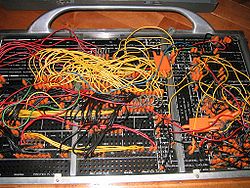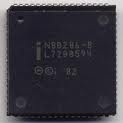Categories: Featured Articles » Interesting Facts
Number of views: 34908
Comments on the article: 3
The development of the electronic components base
 In 1898, in the illustrated weekly journal The Journal of Newest Discoveries and Inventions, an article was published entitled “The Home Device of Wireless Wiring Experiments.” The transmitter was made on a Rumkorf coil, and the receiver, in fact, was very similar to A.S. Popova. Using the described receiver and transmitter, it was possible to transmit a signal at a distance of 25 m, which for that time was a huge achievement.
In 1898, in the illustrated weekly journal The Journal of Newest Discoveries and Inventions, an article was published entitled “The Home Device of Wireless Wiring Experiments.” The transmitter was made on a Rumkorf coil, and the receiver, in fact, was very similar to A.S. Popova. Using the described receiver and transmitter, it was possible to transmit a signal at a distance of 25 m, which for that time was a huge achievement.
Already in 1924 the first issue of the radio amateur magazine was published. In mid-1930, the magazine was renamed "Radio Front" and under this name it was published until July 1941. During the years of World War II, the magazine, of course, was not published. The first post-war issue of the magazine was released in January 1946. It was from this January issue that the magazine became known as Radio. Its cover is shown in the figure.
The most striking thing about this issue is that after the circuits of the detector receivers, the color marking of the resistors is given, as it is today! True, it also says that this is a new American marking. In Russia, “striped” resistors appeared only at the end of the twentieth century, and even then inside imported radio tape recorders and televisions. But "ours" succeeded in color-coded semiconductors: trying for the needs of the defense industry, they classified everything to such an extent that it became simply impossible to understand what kind of transistor or diode it was. This color marking began to be fully published only at the present time, only domestic transistors have practically ceased to be used.

Fig. 1. Cover of the first issue of Radio magazine
At first, the magazine described the design of tube receivers, transmitters, and audio amplifiers. From the very first issues, Radio magazine published reference data for electronic tubes and other radio components. Questions were also being decided on where to begin amateur radio experiments: from studying the theory, or immediately picking up a soldering iron?
The amateur radio element base
An interesting historical fact: when it was not yet electric soldering iron, then the usual five-copeck coin came to the rescue. It was sharpened in a certain way and riveted to an iron wire with a wooden handle. Being heated in the flame of an alcohol lamp, the coin completely coped with the function of a soldering iron. Now, of course, such advice seems simply ridiculous, but it was!
With a modern element base, which is constantly updated with new microcircuits and transistors, there is simply nothing to do with such a “soldering iron”, because in some cases it is necessary to use a microscope to repair electronic equipment. Thus, the elemental base determines not only the design of electronic devices, but also what tools these devices will be assembled or repaired.
Quite simply and clearly, the development of the element base can be traced on various generations of computers, according to modern computer terminology. For almost forty years now, the growing market for personal computers, as a locomotive, has been dragging silicon technology behind itself, which causes the appearance of more and more electronic components.
Electromechanical computers
Even before the creation of computers, electromechanical computing devices were used - tabs. The first tabulator was invented back in 1890 by Hermann Hopperit in the USA, to calculate the results of a census. Information was entered using punch cards, and the processing results were issued in the form of printouts on paper.
Tabulators were the main equipment of machine-counting stations - MSS. In the USSR, MSS survived to the seventies of the twentieth century, at least as part of large state enterprises. The main objective of the MCC was payroll.It was from there that settlement sheets appeared, which are still called “roots”.
The appearance of the “modern” tabulator is shown in the figure (the square from the right side is the work program typed by wires on the patch panel). The weight of such computer technology reached 600 kg.

Fig. 2. Tab
The “program” is shown in the following figure. Colored wires connected the sockets, which on the other side of the textolite panel ended with contacts for connection to the tabulator.

Fig. 3. Patch tab panel
In 1939, in the USA, by order of the military, IBM developed the Mark 1 computer. Its elemental base was electromechanical relays. She completed the addition of two numbers in 0.3 seconds, and the multiplication in 3. Mark 1 was designed to calculate ballistic tables. Computer Mark 1 contained about 750 thousand parts, the connection of which required 800 km of wires. Its dimensions: height 2.5 m, length 17 m.
Generations of computers and element base
The first generation of computers was built on electronic tubes. So in the UK in 1943, the Colossus computer was created. True, it was highly specialized, its purpose was to decipher German codes by enumerating different options. The device contained 2000 lamps, while the speed was 500 characters per second.
The first universal tube computer is ENIAC, created in 1946 in the United States by order of the military. The dimensions of this computer are very impressive: 25 m in length and almost 6 m in height. The machine contained 17,000 electron tubes and performed about 300 multiplication operations per second, which is much more than the Mark 1 relay machine. The power consumption was about 150 kW. Using computer calculations, the ENIAC proved the theoretical possibility of creating a hydrogen bomb.
In the Soviet Union in the period from 1948 ... 1952, the development of tube computers was also carried out, as in the United States, used mainly by the military. One of the best Soviet-made tube computers should be recognized as the BESM series machines (large electronic calculating machine). In total, six BESM-1 ... BESM-2 (tube) BESM-3 ... BESM-6 models were already manufactured with transistors. At the time of creation, each model in this series was the best in the world in the class of universal computers.
The second generation of computers 1955 - 1970
The elemental base of the second generation was transistors and semiconductor diodes. Compared with tube computers, transistor computers were smaller, power consumption was also much lower. The performance of second-generation computers reached up to half a million operations per second, external storage devices on magnetic media appeared - magnetic tapes and magnetic drums, algorithmic languages and operating systems were created.
The third generation of computers 1965 - 1980
For the third generation, microcircuits of small and medium degree of integration were used as an element base - up to several tens of semiconductor elements were contained in one housing. First of all, they were microcircuits of the K155, K133 series. The speed of such computers reached 1 million operations per second, monochrome alphanumeric video terminals appeared (teletypes and special typewriters were used in second-generation machines).
Further development of the element base led to the creation of microcircuits of large (LSI) and super-large (VLSI) integration. In one case of such microcircuits contains several hundred elements. These microcircuits in the USSR were represented by the K580 series.
Fourth Generation Computer 1980 - Present
This generation was born thanks to the creation by Intel of a microprocessor in 1971, which was simply revolutionary. The Intel 4004 chip with a crystal size of 3.2 * 4.2 mm, contained 2300 transistors and had a clock frequency of 108 KHz. Its computing power was equivalent to the ENIAC computer. On the basis of this device, a new type of computer micro - computer was created.The first personal computers (PCs) were released in 1976 by Apple, but in 1980, IBM took the lead by creating its own IBM PC, whose architecture has become the international standard for professional PCs. Intel’s current second-generation Core i7 processors contain over a billion transistor structures.

Fig. 4. Mandcroprocessor intel
Microcontrollers
A story about the development of the electronic components base of radio electronics would be incomplete if not to mention microcontrollers so popular now in amateur radio designs. According to old terminology, they were called single-chip microcomputers.
The microprocessor, program memory and random access memory, information input / output ports are combined in one multi-output case. To calculate the time intervals, microcontrollers have timers, many models have analog inputs, which allows you to do without external ADC devices. Controllers with a PWM module (PWM) are used in circuits of inverter welding machines and adjustable drives of asynchronous electric motors. There are even controllers with a built-in radio channel, which allows for wireless connection.
The first microcontroller of the MCS-48 family of Intel 8048 was released in 1976. It had 27 I / O lines, an eight-bit timer, data memory and program memory, and, of course, a microprocessor. Currently, these microcontrollers have become history.
See this topic: Microcontroller programming for beginners
8051 controllers
In 1980, the Intel 8051 family (MCS-51) was born. The architecture of this family turned out to be so successful that the microcontrollers of this family are still used today. Of course, during this time, various firms (about a dozen) have developed many models of this family. An interesting fact: the microprocessor instruction system has never changed since its inception, which did not prevent the development of new models of microcontrollers. Over time, the MCS-51 gives way to newer families.
One of these became Microchip PIC microcontrollers. Their popularity was caused, first of all, by low price, high speed, convenient ports. Therefore, MK PICs became the best when you want to create an inexpensive and fairly simple control system.
The huge popularity of microcontrollers among hams is caused not only by the low price of these microcircuits, but also by the fact that to create a new device, it is enough to simply write another program to the MK. Then even without changing anything in the circuit, you can, for example, make a clock or a multi-channel timer from a frequency meter.
Fifth generation computer
In fact, the struggle for its creation between the firms began in 1981. The fifth generation of computers is supposed to look like a human brain controlled by voice. The creation of such artificial intelligence will require the development of completely different technologies, completely different technical solutions, and the creation of a completely new elemental base. Huge efforts in this regard have been made by Japan, but the result has not yet been achieved. The USA does not want to lag behind Japan either - IBM also conducts research in this area. But special achievements are also not yet visible.

Fig. 5. Modern microprocessor
Consumer Electronics
As already mentioned above, the rapidly growing, developing PC market has become the locomotive for the development of electronics. Thanks to this, modern household appliances resemble a specialized computer. TVs, home cinemas, DVD players have such operational parameters that twenty years ago it was simply impossible to imagine.
Even washing machines, refrigerators, simple new year garland controlled by microcontrollers. Modern singing and talking children's toys made in China, also with microcontroller control.By the way, a striking fact: back in the sixties of the twentieth century, the Chinese could not even launch the production of detector receivers, and now almost all electronics are made in China.
In industry, also any modern technological process control device, even not very complex, is based on microcontrollers and, as a rule, has an interface for connecting to a PC. Such an interface are, for example, electronic electricity metersthat allows you to use them in automatic metering systems.
The reliability of modern electronic components is quite high. Nevertheless, it is not uncommon for any electronic equipment to become unusable and in need of repair. IN case of breakdown of household electronic equipment it is not always possible to take the faulty device to a specialized workshop, it’s just not everywhere they are. Then radio amateurs come to the rescue, repairing equipment in their home workshops.
The qualifications of such home masters, as a rule, are very high, because a very wide range of electronic equipment is being repaired: from simple doorbells to satellite television systems. The organization and organization of such workshops at home will be discussed in the next article.
Boris Aladyshkin
See also on our website:
Radio amateur workshop - tools, materials and measuring instruments for work
See also at bgv.electricianexp.com
:
